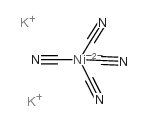14220-17-8
| Name | potassium tetracyanonickelate(2-) |
|---|---|
| Synonyms |
Nickelate(2-),tetrakis(cyano-C)-,dipotassium,(SP-4-1)
Dipotassium nickel tetracyanide Nickelate,tetracyano-,dipotassium Potassium tetracyanonickelate(II) Nickelate(2-),tetrakis(cyano-kappaC)-,dipotassium,(SP-4-1) Dipotassium tetracyanoniccolate dipotassium,nickel(2+),tetracyanide Dipotassium tetracyanonickelate EINECS 238-082-7 Potassium tetracyanonickelate MFCD00049669 |
| Density | 1.875 |
|---|---|
| Boiling Point | 25.7ºC at 760mmHg |
| Melting Point | 100°C -H₂O |
| Molecular Formula | C4K2N4Ni |
| Molecular Weight | 240.96000 |
| Exact Mass | 239.87500 |
| PSA | 95.16000 |
| LogP | 0.06712 |
Synonym: Section 2 - COMPOSITION, INFORMATION ON INGREDIENTS
Risk Phrases: 22 42/43 45 Section 3 - HAZARDS IDENTIFICATION EMERGENCY OVERVIEW
Harmful if swallowed. May cause sensitization by inhalation and skin contact. May cause cancer.Moisture sensitive. Potential Health Effects Eye: May cause eye irritation. Skin: May be harmful if absorbed through the skin. May cause sensitization by skin contact. Ingestion: Harmful if swallowed. Inhalation: May be harmful if inhaled. May cause respiratory sensitization. Chronic: May cause cancer in humans. Section 4 - FIRST AID MEASURES Eyes: Immediately flush eyes with plenty of water for at least 15 minutes, occasionally lifting the upper and lower eyelids. Get medical aid. Skin: Get medical aid. Immediately flush skin with plenty of water for at least 15 minutes while removing contaminated clothing and shoes. Ingestion: Get medical aid immediately. Wash mouth out with water. Inhalation: Remove from exposure and move to fresh air immediately. If not breathing, give artificial respiration. If breathing is difficult, give oxygen. Get medical aid. Notes to Physician: Section 5 - FIRE FIGHTING MEASURES General Information: As in any fire, wear a self-contained breathing apparatus in pressure-demand, MSHA/NIOSH (approved or equivalent), and full protective gear. Substance is noncombustible. Extinguishing Media: Use extinguishing media most appropriate for the surrounding fire. Section 6 - ACCIDENTAL RELEASE MEASURES General Information: Use proper personal protective equipment as indicated in Section 8. Spills/Leaks: Vacuum or sweep up material and place into a suitable disposal container. Section 7 - HANDLING and STORAGE Handling: Do not breathe dust, vapor, mist, or gas. Do not get in eyes, on skin, or on clothing. Use only in a chemical fume hood. Storage: Store in a cool, dry place. Store in a tightly closed container. Section 8 - EXPOSURE CONTROLS, PERSONAL PROTECTION Engineering Controls: Use adequate ventilation to keep airborne concentrations low. Exposure Limits CAS# 14220-17-8: Personal Protective Equipment Eyes: Not available. Skin: Wear appropriate protective gloves to prevent skin exposure. Clothing: Wear appropriate protective clothing to prevent skin exposure. Respirators: Follow the OSHA respirator regulations found in 29 CFR 1910.134 or European Standard EN 149. Use a NIOSH/MSHA or European Standard EN 149 approved respirator if exposure limits are exceeded or if irritation or other symptoms are experienced. Section 9 - PHYSICAL AND CHEMICAL PROPERTIES Physical State: Crystals Color: yellow to orange Odor: Not available. pH: Not available. Vapor Pressure: Not available. Viscosity: Not available. Boiling Point: Not available. Freezing/Melting Point: Not available. Autoignition Temperature: Not available. Flash Point: Not available. Explosion Limits, lower: Not available. Explosion Limits, upper: Not available. Decomposition Temperature: Solubility in water: Soluble. Specific Gravity/Density: Molecular Formula: C4K2N4Ni Molecular Weight: 240.9134 Section 10 - STABILITY AND REACTIVITY Chemical Stability: Stable. Conditions to Avoid: Incompatible materials, exposure to moist air or water. Incompatibilities with Other Materials: Acids, bases, oxidizing agents, carbon dioxide. Hazardous Decomposition Products: Hydrogen cyanide, carbon monoxide, nickel oxide, oxides of potassium. Hazardous Polymerization: Will not occur. Section 11 - TOXICOLOGICAL INFORMATION RTECS#: CAS# 14220-17-8: QR8650000 LD50/LC50: CAS# 14220-17-8: Oral, mouse: LD50 = 275 mg/kg. Carcinogenicity: Potassium tetracyanonickelate(II) hydrate - California: carcinogen, initial date 5/7/04 (listed as Nickel compound NTP: Known carcinogen (listed as Nickel compounds). IARC: Group 1 carcinogen (listed as Nickel compounds). Other: See actual entry in RTECS for complete information. Section 12 - ECOLOGICAL INFORMATION Section 13 - DISPOSAL CONSIDERATIONS Dispose of in a manner consistent with federal, state, and local regulations. Section 14 - TRANSPORT INFORMATION IATA Not regulated as a hazardous material. IMO Not regulated as a hazardous material. RID/ADR Not regulated as a hazardous material. Section 15 - REGULATORY INFORMATION European/International Regulations European Labeling in Accordance with EC Directives Hazard Symbols: T Risk Phrases: R 45 May cause cancer. R 22 Harmful if swallowed. R 42/43 May cause sensitization by inhalation and skin contact. Safety Phrases: S 53 Avoid exposure - obtain special instructions before use. S 22 Do not breathe dust. S 24 Avoid contact with skin. S 45 In case of accident or if you feel unwell, seek medical advice immediately (show the label where possible). WGK (Water Danger/Protection) CAS# 14220-17-8: No information available. Canada CAS# 14220-17-8 is listed on Canada's DSL List. CAS# 14220-17-8 is listed on Canada's Ingredient Disclosure List. US FEDERAL TSCA CAS# 14220-17-8 is listed on the TSCA inventory. SECTION 16 - ADDITIONAL INFORMATION N/A |
CHEMICAL IDENTIFICATION
HEALTH HAZARD DATAACUTE TOXICITY DATA
|
| Hazard Codes | T:Toxic; |
|---|---|
| Risk Phrases | R22;R42/43;R45 |
| Safety Phrases | S53-S22-S36/37-S43-S45 |
| RIDADR | UN 1588 6.1/PG 2 |
| WGK Germany | 3 |
| RTECS | QR8650000 |
| Packaging Group | III |
| Hazard Class | 6.1(b) |
| HS Code | 2837200011 |
| HS Code | 2837200011 |
|---|
